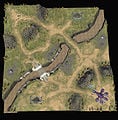Blood River
From Halopedia, the Halo wiki
| Blood River | |
|---|---|

| |
| Map overview | |
|
Game: |
|
| Lore information | |
|
Location: |
Presumably Trove interior |
| Gameplay overview | |
|
Terrain: |
|
|
Recommended number of players: |
1v1 (2 players) |
| “ | Secure base locations on nearby cliffs overlook this naturally red-tinged river. The soldiers that fought over its two narrow crossings gave the river its name, which has since taken on a greater meaning. | ” |
Blood River is a multiplayer map for Halo Wars, added by the Historic Battle map pack.[1]
The map features two opposing regions cut in half by a river, which could only be crossed with two bridges, one of which is light bridge. The starting bases are located atop the hilltops in the opposing corners. There is a Forerunner supply elevator on each side of the river, both featuring Covenant watchtowers next to them. Additionally, each sides of the map feature a Forerunner secondary reactor and a base site (initially occupied by a Forerunner fort). All three sites are defended by Aggressor Sentinels.
Strategy[edit]
- A good tactic is to hold the two bridges; if the player can gain control of them, enemy ground forces would be prevented from reaching the starting base.
- On the other hand, another good tactic is to rely on air units to make the two bridges irrelevant to the ensuing battle. But if the player chooses this tactic, their base is vulnerable to a large-scaled ground assault.
- Both bases are situated on top of hills, so long range units can annihilate enemy forces coming up the hill if put in the ideal locations.
- There are supply elevators located next to both bases, they are a good idea to garrison as they also act as a good defensive position.
Trivia[edit]
- Disrupting 5 active leader powers on this map will reward the player with the achievement Killjoy, worth 25 gamerpoints.
- This is the only 1v1 map in Halo Wars to have Forerunner Sentinels serve as the neutral faction.
Gallery[edit]

|
Browse more images in this article's gallery page. |
Sources[edit]
| ||||||||||||||||||||||||||||


